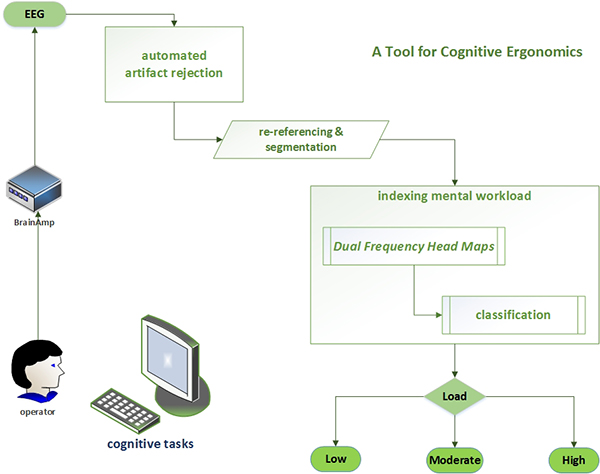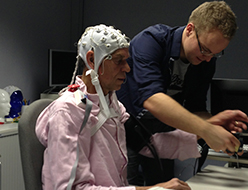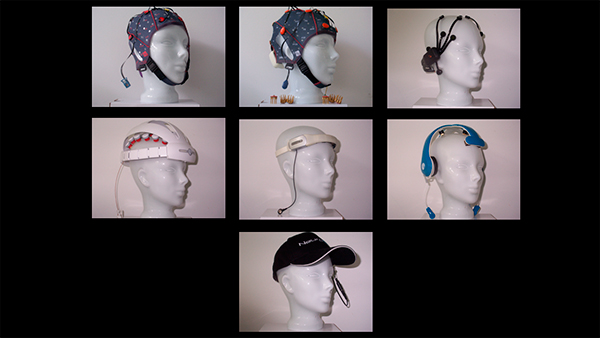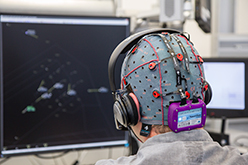Information-intensive work and its effect on people
Digitalisation has fundamentally changed our world of work. The associated requirements for acquiring and processing information have consequences on the perceived mental workload. The measuring and evaluating of this is the task of our research.
Avoiding negative or impairing consequences of mental workload is a precondition for the health of employees. For this purpose, it is necessary to know how high the strain caused by work actually is. The aim of our research is to measure mental workload over time and evaluate it in order to detect workload peaks.
Determining mental workload with the help of neurophysiological parameters
There are various methods available for measuring mental workload.
Methods for determining mental workload
The methods for determining mental workload can be divided roughly into two categories: subjective and objective evaluation methods. In subjective evaluation methods, questionnaires register the experienced workload, whereas the objective determination of mental workload is based on behavioural data and physiological parameters.
Development of an objective method for determining mental workload
Years of research in the USA on analyses of electroencephalograms (EEG), the findings of numerous EEG studies and our own preliminary work are the basis for the development of a method for the continuous determination of mental workload using an EEG. The findings show that variations in the EEG’s power spectrum in the θ and α frequency bands (4-8 Hz; 8-12 Hz) accompany changes of load level.
Our examinations took place in the shielded laboratory of the Federal Institute for Occupational Safety and Health (BAuA) in Berlin. The 57 subjects who took part in the examination worked on cognitive tasks of varying complexity during which their brain activity was recorded.
The examinations confirm the tendency generally known from literature that increasing difficulty of tasks is accompanied by an increase in the power spectrum of the frontal θ band and a decrease in the power spectrum of the parietal α band. They form the basis for our own approach on the development of the new objective method.


Measuring mental workload on the basis of electroencephalography has one advantage: workload is measured where information processing takes place, namely the brain. Preliminary work on the development of a method for the continuous determination of mental workload has been carried out as part of the research by the Federal Institute for Occupational Safety and Health.
Measuring mental workload under realistic conditions
Measuring mental workload with the help of the EEG presupposes interference-free recording to ensure good signal quality. Furthermore, it is important to utilise user-friendly EEG measuring systems. This requires the testing of marketable devices with regard to usability, user-friendliness and acceptance.

Examination of the usability of mobile EEG devices
As part of the research project, BAuA is testing seven EEG recording systems currently available on the market.
Testing is being carried out on:
- the application time of the electrodes,
- the learning effort for operating the recording systems,
- the possible wearing time and the comfort of the new EEG electrode systems.
Another important criterion is the design of the EEG headsets, i.e. their ability to adapt to different head shapes to assure a good contact of the electrodes with the head surface. This is necessary to derive the EEG with as few artefacts as possible.
The aim of the examinations is to identify EEG recording systems that affect the user the least and to ensure good quality of the results due to fewer secondary effects during EEG recording.
Validating the method for determining mental workload
The validation of the method for determining mental workload is carried out in cooperation with the Department for Controller Assistance at the Institute of Flight Guidance, German Aerospace Center, (Deutsches Zentrum für Luft- und Raumfahrt, DLR) Braunschweig. In an interactive simulation, this project focuses on arrival management, that is, on approach control. Approach controllers are responsible for pilots keeping to the stipulated flight altitudes. They are also responsible for aircrafts starting to land at a suitable rate.
To which extent the method for continuous mental workload registration developed by BAuA can differentiate reliably between different simulated stress level conditions needs to be examined. Researchers use already known rules and regulations for air traffic controllers to simulate stress situations at different levels realistically.

For practical use, it must be shown that the new method can differentiate among the various workload states reliably and correctly. The respective test is carried out at the German Aerospace Centre (DLR) in Braunschweig.
In the long run, the method is to be employed to continuously record mental workload in information-intensive work activities.